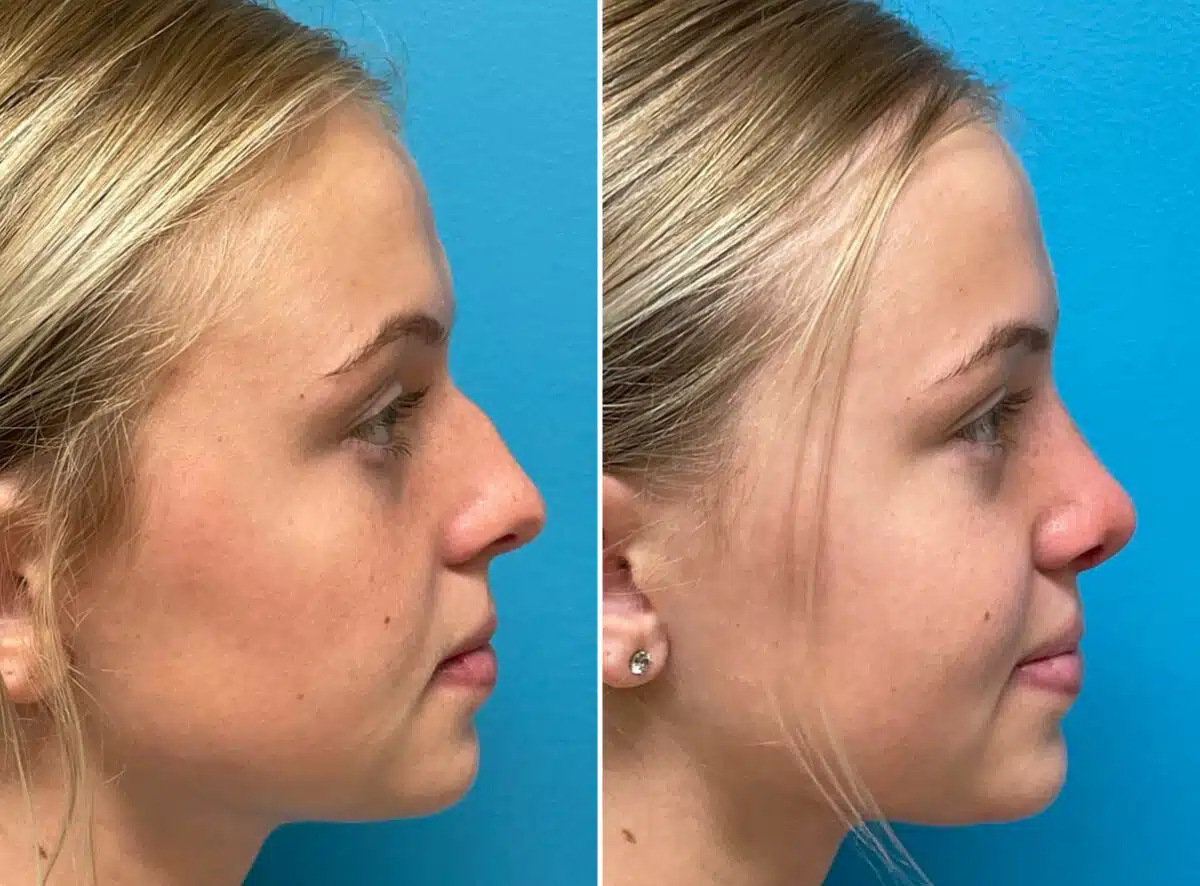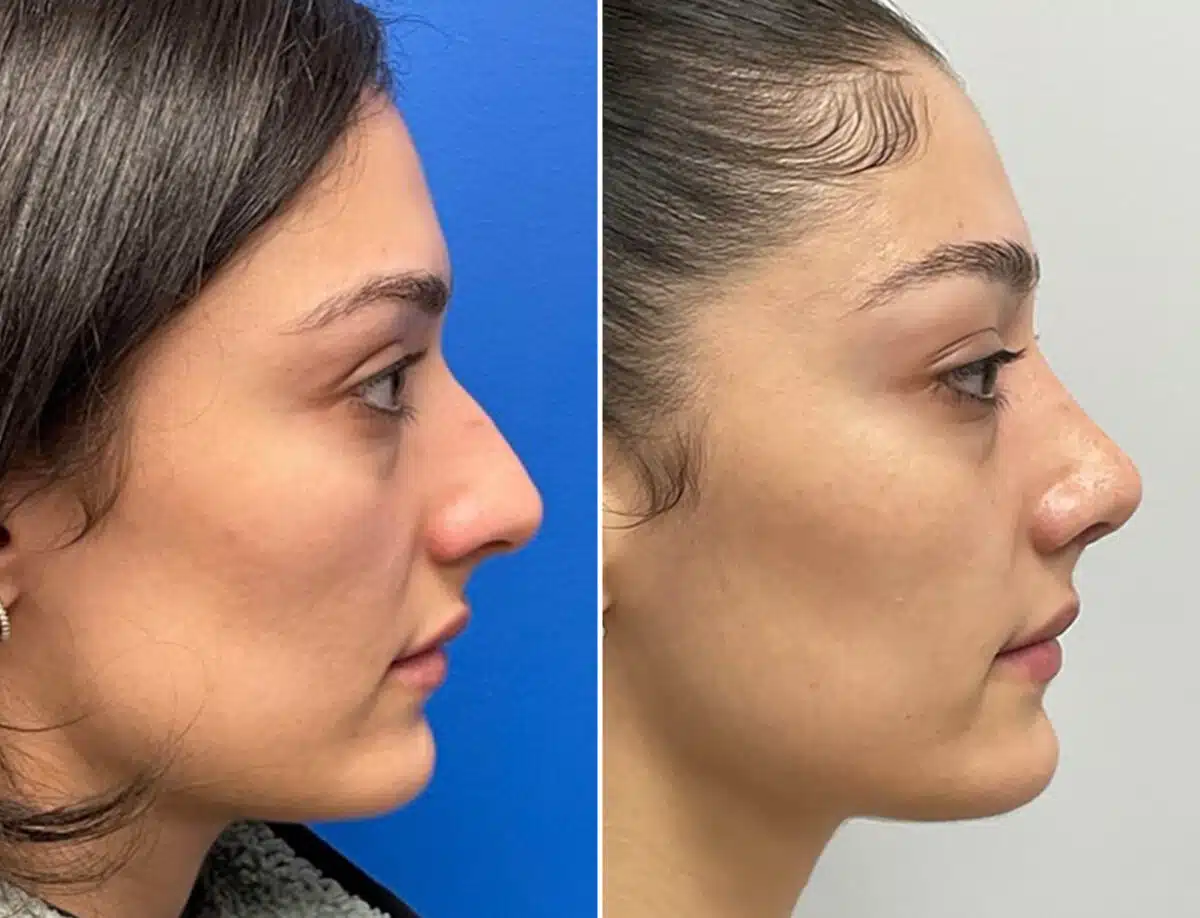Does Liquid Rhinoplasty Last Forever?

A lot of people choose liquid rhinoplasty over standard surgical rhinoplasty. It is also called non-surgical rhinoplasty. This modern dermal filler treatment doesn’t hurt and is meant to change the shape and look of the nose without major surgery. The process is quick—it usually only takes 15 to 30 minutes—and there isn’t much recovery time, so patients can get back to their normal lives right away. The effects happen right away, but they won’t last forever.
How Long Does Liquid Rhinoplasty Last?
This innovative, non-invasive dermal filler procedure often produces results that last 9 to 18 months. However, this length is not fixed and might vary greatly from person to person.
One explanation for this variation is that temporary fillers, typically hyaluronic acid-based, are used to accomplish the intended reshaping and contouring of the nose in liquid rhinoplasty, which is commonly thought of as an anti-aging treatment among several facial rejuvenation procedures.
Over a while, these fillers are naturally absorbed by the body, causing the effects of the procedure to gradually diminish.
Factors That Can Impact the Longevity of Liquid Rhinoplasty
Metabolism, Skin, and Individual Response to Fillers

The patient’s metabolism is one of the important factors that can affect how long the results of a liquid rhinoplasty last. A person with a faster metabolism might metabolize the hyaluronic acid-based filler more quickly, leading to a shorter duration of results. This is a common question that patients have during the consultation time, and it’s important to understand that everyone’s body responds differently to treatments.
The patient’s skin type and individual response to fillers can also play a significant role in the longevity of the results. For instance, skin firmness and skin cell receptors can affect how the filler settles and is absorbed.
Similarly, individual patient reactions to the filler could also affect the longevity of the results. This is why it’s so important to plan treatments in great detail so that the best treatment for each patient is picked.
Type and Quality of Fillers Used
The type and quality of fillers used in a liquid rhinoplasty, or non-surgical nose treatment, can significantly impact the longevity of the results. Hyaluronic acid-based fillers are a popular choice for this cutting-edge, non-invasive dermal filler treatment because of its natural anti-aging and face rejuvenation properties.
The most popular hyaluronic acid-based fillers are known for their ability to provide a youthful appearance and improve skin firmness. However, the duration of the results can vary depending on the specific filler used.
For profile balance, the quality of the filler is just as important as the type of filler. Fillers of higher quality are less likely to cause minor pain or cause more swelling after the operation. They also tend to break down more slowly, which means that upkeep injections aren’t needed for as long.
Skill and Experience of the Injector
Achieving the intended outcomes depends mostly on the injector’s expertise and experience in doing non-surgical nose therapy. More likely to apply the advanced, non-invasive dermal filler therapy in a way that maximizes its lifetime is a board-certified facial plastic surgeon or reconstructive surgeon, especially one with an eye toward facial rejuvenation therapies. These experts can produce a balanced, natural-looking face by knowing facial features rather well.
Also, with the help of a skilled provider, patients can go through the process of treatment planning in great detail, which allows them to fully grasp the treatment’s advantages and establish reasonable expectations for their facial rejuvenation. In addition to surgical rhinoplasty options, they can recommend non-invasive alternatives, such as the most popular hyaluronic acid-based fillers or other types of fillers.
Proper Aftercare and Maintenance After Recovery Time
It is crucial to take the necessary steps to care for and maintain your new nose after a liquid rhinoplasty. Despite being less intrusive than conventional rhinoplasty surgery, this non-surgical option still necessitates meticulous preparation and a personalized strategy for optimal outcomes.
Following the short operation, which usually causes little pain and suffering, patients should expect a recovery time much less than that of a surgical treatment. The course of treatment does not finish with the recuperation phase, though.
A personalized treatment protocol is essential to maintain the results of this advanced, non-invasive dermal filler treatment. This includes avoiding intense activities and applying pressure to the injected area for 1 to 2 weeks following the operation. This permits the hyaluronic acid-based filler to settle properly, lowering the likelihood of contour abnormalities.
Secure Your Safe Treatment Experience with Dr. Daniel G. Becker.
Join our satisfied clients who’ve experienced safe, effective treatments.
Potential Risks and Side Effects of The Non-Surgical Nose Job
As with any facial rejuvenation treatment, the non-surgical nose job carries potential risks and side effects. Injection site swelling, pain, and bleeding are possible side effects that patients may encounter right after the operation. These are typical reactions to injectable fillers and typically go away after a few days.
Alternatives to the Hyaluronic Acid Rhinoplasty
Permanent Non-Surgical Rhinoplasty
One such alternative is the use of Silikon-1000, an injectable filler used in microdroplet silikon-1000 treatments. This is a minute treatment that can be tailored to the individual patient’s needs through a personalized treatment protocol. Silikon-1000 nasal treatments offer a more permanent solution compared to hyaluronic acid-based treatments, providing longer-lasting results that can help maintain a youthful appearance.
Traditional Rhinoplasty
For those seeking a more drastic change, traditional rhinoplasty surgery is another alternative. This plastic surgery procedure can offer a permanent solution to issues such as a crooked nasal appearance or the appearance of bumps on the nasal bridge.
However, it’s important to note that this option involves a more lengthy recovery time compared to non-surgical treatments. While this procedure involves more invasive surgery and a longer recovery time, it offers permanent results and can also correct structural changes and breathing issues.
Surgical rhinoplasty also carries more risks, including bleeding, infection, and complications from anesthesia.
Choosing The Best Rhinoplasty Surgeon for Your Treatment
When selecting the surgeon for your rhinoplasty procedure, the ideal surgeon should be a board-certified facial plastic surgeon with experience in both non-surgical and surgical treatments.
The Becker Rhinoplasty Center in New Jersey is helmed by Dr. Daniel G. Becker, a board-certified facial plastic surgeon who provides extensive expertise in rhinoplasty and revision procedures. The center provides various rhinoplasty options to address issues, including droopy noses, bulbous tips, and fractures.
Patients praise Dr. Becker for his caring approach and excellent outcomes, reflecting his philosophy of prioritizing patient satisfaction and natural results. If you want to learn more about a nose job, Dr. Becker provides rhinoplasty education for his patients, showing his passion and care for rhinoplasty.
Contact us to schedule your liquid rhinoplasty consultation today.

